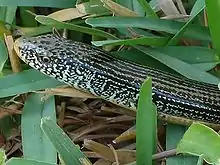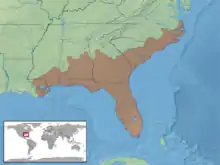Eastern glass lizard
The eastern glass lizard (Ophisaurus ventralis) is a species of legless lizard in the family Anguidae, endemic to the Southeastern United States. The streamlined, legless species is often confused with snakes. Glass lizards differ from snakes as they possess a moveable eyelid and an external ear opening, both of which are absent in snakes. Ventralis comes from the Latin "venter" meaning belly; this is in reference to the snake-like movement. [5]
| Eastern glass lizard | |
|---|---|
 | |
| Scientific classification | |
| Domain: | Eukaryota |
| Kingdom: | Animalia |
| Phylum: | Chordata |
| Class: | Reptilia |
| Order: | Squamata |
| Family: | Anguidae |
| Genus: | Ophisaurus |
| Species: | O. ventralis |
| Binomial name | |
| Ophisaurus ventralis (Linnaeus, 1766) | |
 | |
| Synonyms[2][3][4] | |
Description
Adults of O. ventralis grow to 46–108 cm (18–43 in) in total length, although the head-body length is only 30.5 cm (12.0 in) at most. There are 99 or more scales along the lateral groove. In this species, no dark longitudinal stripes are present below the lateral groove or under the tail, and there is no distinct mid-dorsal stripe. The neck is marked with a series of mostly vertical, or highly irregular, white marks, with white markings on posterior corners of scales. Palatine teeth are present.[6] Dorsally, older specimens have a pattern consisting of numerous longitudinal dark lines or dashes. Occasionally, similar parallel lines cover the entire mid-dorsal area. Older adults may be greenish above and yellow below; this is the only Ophisaurus species that may have a greenish appearance. Juveniles are khaki-colored and usually have two dark stripes that run down the back.[7] O. ventralis are commonly mistaken as a species of snake because they lack limbs. Unlike snakes, they have moveable eyelids, external ear openings located behind their eyes, and inflexible jaws. [8] The three extant species of Ophisaurus that live in North America can be distinguished by their differences in number of teeth and sizes of skulls from skeletal analysis.[9]
No subspecies are currently recognized.[2]
Habitat
Eastern glass lizards are a common species near wetlands and moist soils.[10] O. ventralis habitat consists of flatwoods adjacent to wetlands with sandy soils. They heavily rely on prescribed fire to maintain their habitat. [11] They have also been found in tidal areas such as coastal dunes because they are resistant to salty conditions.[12] Eastern glass lizards are most active during the day and can be found foraging in open habitats but also like to take refuge beneath debris.[13]
A study in 2020 found O. ventralis using a crayfish burrow as habitat in southeastern Mississippi. Various invertebrates and vertebrates are known to use these burrows but this is the first time a lizard species has been documented using a crayfish burrow. Limited research has been done but it could represent more widespread behavior.[14] Direct mortality due to prescribed fire is of concern to land managers using fire as a management tool in the eastern glass lizard's habitat. [15]
Distribution
O. ventralis is commonly found from extreme southeastern Virginia to south Florida and west to Louisiana. They are restricted to the coastal plains of the southeastern United States, and populations are restricted by the Mississippi River.[16][17] Isolated records exist of its occurrence in Oklahoma and Missouri.[7]
Diet
O. ventralis eats a range of insects, such as grasshoppers, crickets and beetles, and will also consume spiders, small mice, snails, and the eggs of other reptiles and ground-nesting birds. Unlike snakes, glass lizards do not have flexible jaws, and this limits the size of prey items they can consume. They forage both above ground and underground in burrows.[18]
Predator and predator avoidance
Common predators of the eastern glass lizard include skunks, raccoons, foxes, snakes, and cats. They have the ability of tail autotomy, meaning their tail breaks off upon restraint. Their tail fragment will continue to writhe for several minutes after detachment to distract the predator and allow them to escape. [19]
Reproduction
O. ventralis is oviparous and lays around 5–15 eggs in June and July. Eggs are usually laid under cover or in depressions and sandy or loamy soil. Females will encircle their clutch but may retreat when approached and generally do not defend their eggs. [20]
Gallery
 Male in South Carolina
Male in South Carolina Female with eggs
Female with eggs Hatchlings
Hatchlings In Florida
In Florida.jpg.webp) With tail broken off
With tail broken off Eastern glass lizard - Valdosta GA, USA
Eastern glass lizard - Valdosta GA, USA
References
- Hammerson, G.A. (2007). "Ophisaurus ventralis". IUCN Red List of Threatened Species. 2007: e.T63721A12710178. doi:10.2305/IUCN.UK.2007.RLTS.T63721A12710178.en. Retrieved 19 November 2021.
- "Ophisaurus ventralis ". Integrated Taxonomic Information System. Retrieved 30 June 2008.
- "Ophisaurus ventralis ". The Reptile Database. www.reptile-database.org.
- Stejneger L, Barbour T (1917). A Check List of North American Amphibians and Reptiles. Cambridge, Massachusetts: Harvard University Press. 125 pp. (Ophisaurus ventralis, pp. 60-61).
- Holbrook, John Edwards (1842). "Ophisaurus ventralis – Linnaeus". North American Herpetology; or, A Description of the Reptiles Inhabiting the United States. 2: 139–142. doi:10.5962/p.326791.
- Holbrook, John Edwards (1842). "Ophisaurus ventralis – Linnaeus". North American Herpetology; or, A Description of the Reptiles Inhabiting the United States. 2: 139–142. doi:10.5962/p.326791. S2CID 247888954.
- Conant R (1975). A Field Guide to Reptiles and Amphibians of Eastern and Central North America, Second Edition. (First published in 1958). Boston: Houghton Mifflin Company. xviii + 429 pp. + 48 plates. ISBN 0-395-19979-4 (hardcover), ISBN 0-395-19977-8 (paperback). (Ophisaurus ventralis, pp. 132-133, Figure 30 + Plate 13 + Map 95).
- Liniewski. (2015). Vestigial skeletal structures in seven species of lizards in the families scincidae and anguidae. ProQuest Dissertations Publishing.
- Auffenburg, W. (1955). "Glass Lizards (Ophisaurus) in the Pleistocene and Pliocene of Florida". Herpetologica. 11 (2): 133–136. ISSN 0018-0831. JSTOR 3889977.
- Rodgers, James, A; Schwikert, Stephen, T; Breen, Timothy (2002). "Eastern Glass Lizard as Probable Prey of Great Egrets" (PDF). Florida Field Naturalist. 2: 40.
{{cite journal}}: CS1 maint: multiple names: authors list (link) - Kaufmann, Greg; Smith, Henry T.; Engeman, Richard; Meshaka, Walter; Cowan, Ernest M. (2007-01-01). "OPHISAURUS VENTRALIS (Eastern Glass Lizard). FIRE-INDUCED MORTALITY". USDA Wildlife Services - Staff Publications.
- Adams, S., Bland, M., Glon, M., & Myers, G. (2020). Ophisaurus ventralis (Eastern Glass Lizard) habitat use. Herpetological Review, 51, 602-602.
- Neill, W. T. (1948). The lizards of Georgia. Herpetologica, 4(4), 153-158.
- Adams SB, Bland MR, Glon MG, Myers GA (2020). "Ophisaurus ventralis (Eastern Glass Lizard) habitat use" (PDF). Herpetological Review. 51 (3): 602. Retrieved 2 March 2023 – via fs.usda.gov.
- Kaufmann, Greg; Smith, Henry T.; Engeman, Richard; Meshaka, Walter; Cowan, Ernest M. (2007-01-01). "OPHISAURUS VENTRALIS (Eastern Glass Lizard). FIRE-INDUCED MORTALITY". USDA Wildlife Services - Staff Publications.
- Zadik, J. (4 December 2019). "Eastern Glass Lizard (Ophisaurus ventralis)". South Carolina Partners in Amphibian and Reptile Conservation. Retrieved 17 May 2023.
- Cliburn, J. W. (1959). The Distribution of Some Mississippi Lizards. The American Midland Naturalist, 61(2), 414–418. doi:10.2307/2422510
- BRIMLEY, C. S. (1905). NOTES ON THE FOOD AND FEEDING HABITS OF SOME AMERICAN REPTILES. Journal of the Elisha Mitchell Scientific Society, 21(4), 149–155. http://www.jstor.org/stable/24330512
- Fitch, H. S. (2003). A comparative study of loss and regeneration of lizard tails. Journal of Herpetology, 37(2), 395-399.
- "Virginia Herpetological Society". www.virginiaherpetologicalsociety.com. Retrieved 2022-04-05.
Further reading
- Behler JL, King FW (1979). The Audubon Society Field Guide to North American Reptiles and Amphibians. New York: Alfred A. Knopf. 743 pp. (Ophisaurus ventralis, pp. 544–545 + Plates 453, 456).
- Daudin FM (1803). Histoire Naturelle, Générale et Particulière des Reptiles; Ouvrage faisant suite aux Œuvres de Leclerc de Buffon, et partie du Cours complet d'Histoire naturelle rédigé par C.S. Sonnini, membre de plusieurs Sociétés savantes. Tome septième [Volume 7]. Paris: F. Dufart. 436 pp. (Ophisaurus ventralis, new combination, pp. 352–356 + Plate LXXXVIII). (in French and Latin).
- Linnaeus C (1766). Systema naturæ per regna tria naturæ, secundum classes, ordines, genera, species, cum characteribus, differentiis, synonymis, locis. Tomus I. Editio Duodecima, Reformata. Stockholm: L. Salvius. 532 pp. (Anguis ventralis, new species, p. 391). (in Latin).
- Smith HM, Brodie ED Jr (1982). Reptiles of North America: A Guide to Field Identification. New York: Golden Press. 240 pp. ISBN 0-307-13666-3. (Ophisaurus ventralis, pp. 90–91).
- Zim HS, Smith HM (1956). Reptiles and Amphibians: A Guide to Familiar Species: A Golden Nature Guide. Revised Edition. New York: Simon and Schuster. 160 pp. (Ophisaurus ventralis, pp. 67, 155).
External links
- Eastern Glass Lizard (Ophisaurus ventralis) at SREL Herpetology. Accessed 30 June 2008.
- Eastern Glass Lizard (Ophisaurus ventralis) at Virginia Dept. of Game and Inland Fisheries. Accessed 30 June 2008.
